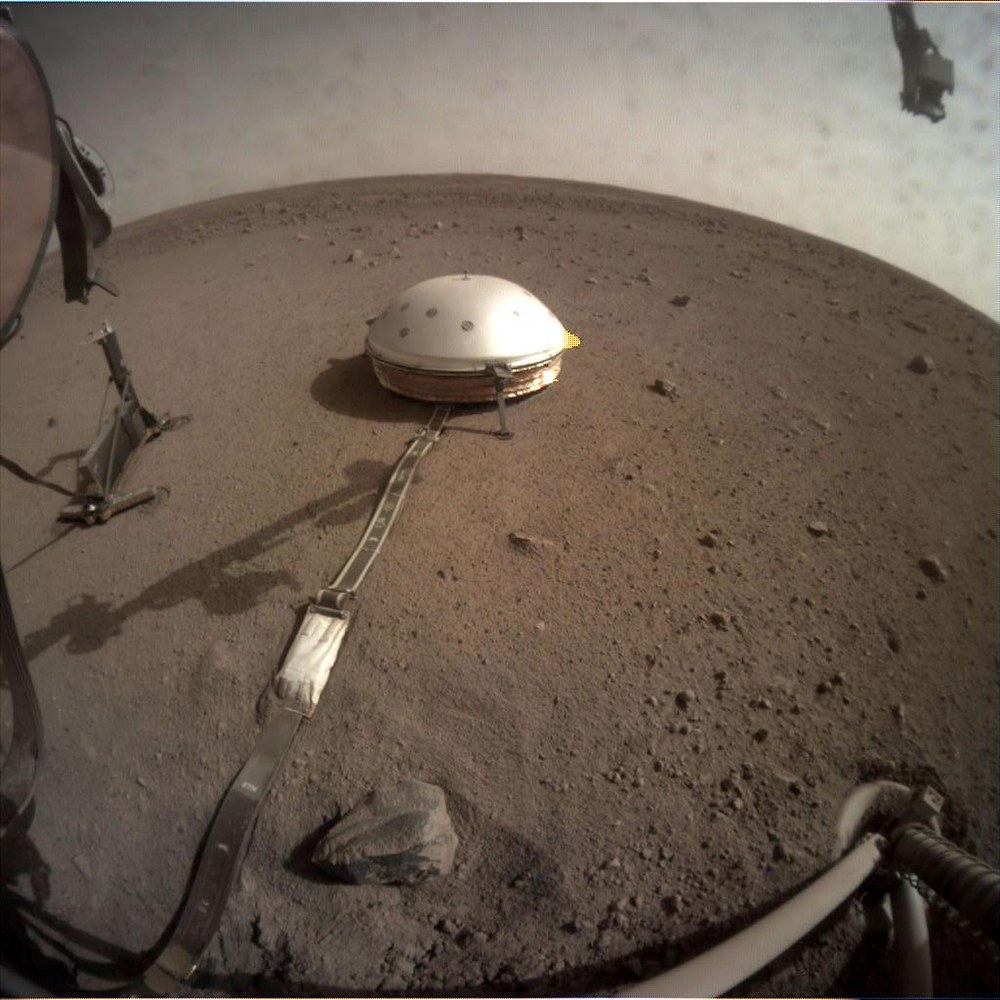InSight mission – Diagnostic run for the 'Mole' on Mars
- Since the Mole has no further progress since it reached a depth of approximately 30 centimetres at the beginning of March, a more detailed analysis of the situation is necessary.
- A diagnostic run will provide further insights and develop ideas for its release.
- Focus: Space travel, exploration
The German Aerospace Center (Deutsches Zentrum für Luft- und Raumfahrt; DLR) will command the Mars ‘Mole’ to begin a short new round of hammering at the end of March. The seismometer and the camera will closely monitor the movement of the Mole. The researchers want to analyse in more detail the situation of the self-hammering probe, which has shown no further progress since it reached a depth of approximately 30 centimetres at the beginning of March. Different ideas for releasing the Mole require a more detailed analysis of the situation and at least a few more weeks to test different strategies on Earth.
"It is still unclear whether the Mole is blocked by a single rock or a layer of gravel, or whether the rear section of the probe is caught in the carrier structure. This could have happened because the device has penetrated the ground at an angle of about 15 degrees to the vertical,” says Tilman Spohn of the DLR Institute of Planetary Research, who is currently reporting on the progress of the mission in a blog. The scientists had hoped that, within a few months of the InSight landing, the Mole would have reached a depth of at least three metres below the Martian surface. Initial measurements of the thermal conductivity of the ground using the Heat Flow and Physical Properties Package (HP³) have now been carried out at a depth of 30 centimetres. The researchers are still hoping to conduct additional measurements at a later date.
The Mole’s team is currently planning a 10- to 15-minute diagnostic hammering test at the end of March. The InSight seismometer will ‘listen’ to the Mole; its behaviour as it encounters the obstacle could possibly give a more precise indication of what is blocking the Mole. The camera on InSight’s robotic arm will image the support structure during the entire process in the hope of capturing any movements the Mole causes while hammering.
In April, DLR will send an exact replica of HP³ to NASA’s Jet Propulsion Laboratory (JPL) in Pasadena, California. This will enable the JPL team, in collaboration with DLR engineers and scientists working on another HP³ replica in Bremen, to begin conducting further tests on Earth.
The HP³ Instrument on NASA’s InSight mission
The InSight mission is being carried out by NASA’s Jet Propulsion Laboratory (JPL) in Pasadena, California, on behalf of the agency’s Science Mission Directorate. InSight is part of NASA’s Discovery Program. DLR is contributing the Heat Flow and Physical Properties Package (HP³) experiment to the mission. The scientific leadership lies with the DLR Institute of Planetary Research, which was also in charge of developing and implementing the experiment in collaboration with the DLR Institutes of Space Systems, Optical Sensor Systems, Space Operations and Astronaut Training, Composite Structures and Adaptive Systems, and System Dynamics and Control, as well as the Institute of Robotics and Mechatronics. Participating industrial partners are Astronika and the CBK Space Research Centre, Magson GmbH and Sonaca SA, the Leibniz Institute of Photonic Technology (IPHT) as well as Astro- und Feinwerktechnik Adlershof GmbH. Scientific partners are the ÖAW Space Research Institute at the Austrian Academy of Sciences and the University of Kaiserslautern. The DLR Microgravity User Support Center (MUSC) in Cologne is responsible for HP³ operations. In addition, the DLR Space Administration, with funding from the German Federal Ministry for Economic Affairs and Energy, supported a contribution by the Max Planck Institute for Solar System Research to the French main instrument SEIS (Seismic Experiment for Interior Structure).
Detailed information on the InSight mission and the HP³ experiment is available on DLR’s dedicated mission site with extensive background articles. You can also find information in the animation and brochure about the mission or via the hashtag #MarsMaulwurf on the DLR Twitter channel. Tilman Spohn, the Principal Investigator for the HP³ experiment, is also providing updates in the DLR Blog portal about the activities of the Mars Mole.


